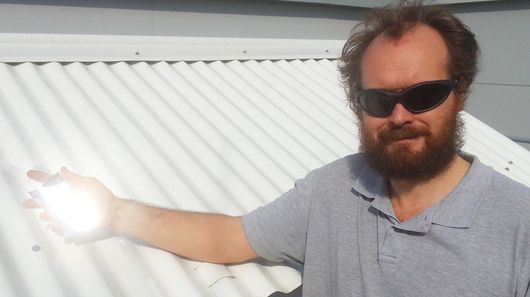Coated polymer stack promises to keep your roof cool in summer
By Nick Lavars
June 1, 2015

Dr Angus Gentle holding a piece of the special material over an existing cool roof used in testing
Image Gallery (2 images)Of all the scenarios you'd want to find yourself in a heatwave, being barefoot on a hot tin roof would be toward the bottom of the list. These exposed surfaces soak up sunlight to slowly but surely transform into corrugated hotplates, compounding the sweltering ambient temperatures and warming the living space below. But a team of Sydney-based scientists has developed a new material that's claimed capable of keeping a rooftop cooler than the air that surrounds it, saving energy and sweating residents in the process.
Led by Dr Angus Gentle and Professor Geoff Smith from the University of Technology Sydney (UTS), the research team used a mixture of commercially available polyesters and a silver layer to build what it describes as a coated polymer stack. It says these materials could be appropriate for use on basic roofing, and could help mitigate the heating effect that can see roofs rise in temperature by as much as nine to 12 degrees Celsius.
The team says the new material holds promise as it absorbs only three percent of incident sunlight, while also radiating heat at infrared wavelengths. In testing the material, the researchers installed it on top of their faculty's building with no obstructions between it and the sun. When comparing it to a nearby state-of-the-art white roof, they found it stayed 11 degrees Celsius cooler.
"We demonstrate for the first time how to make a roof colder than the air temperature around it, even under the most intense summer conditions," says Professor Smith.
The researchers also wanted to investigate how the material performed once dirt and grime had begun to build up on the surface. They collected data on the performance of both an unblemished surface and one that had been in place for a few days and found that it was able to perform at the same high level regardless of its covering.
The combination of scorching temperatures, concrete structures and bitumen found in city centers, known as the heat island effect, is a problem inspiring many research approaches around the world. In 2012, we saw ETH Zurich researchers roll out a special mat to be placed on roofs, soak up rainwater and then sweat it out when the sun emerges to cool the building underneath. The BioSkin urban facade that coats the 25-story NBF Osaki Building in Tokyo uses traditional Japanese cooling techniques such as water-spraying and bamboo blinds to keep temperatures low.
The UTS team says its solution has the potential to both reduce the heat island effect in urban areas and ease the reliance on air conditioning during hot summer months.
The findings of the study were published in the journal Advanced Science.
Source: University of Technology Sydney
http://www.gizmag.com/coated-polymer-stack-roof-cool-summer/37800